President's Message
Fellow woodworkers,
A few weeks ago one of our board members gave me a postcard showing a picture of the magnificent organ built for the Panama-Pacific International Exposition of 1915 held in San Francisco. The card was published by the Friends of the Exposition Organ who are trying to get it restored back to its former glory.

I have always been fascinated by pipe organs. When I was a young Boy Scout the wooden pipes of the church's old organ were stored under the hall stage having been long replaced by a smaller more cost-effective organ; the outsides were covered in soot and dust but fun to play with. Many years later I woke up one morning during the Christmas holidays and in the distance saw that the roof of an old abandoned church had been removed. Quickly driving across town, I found that the stone church was being totally demolished, all the wood just ripped up and pulverized. So with the help of my trailer I was soon the owner of several old organ pipes and a few bits of pews, etc. The pipes were from 3 to about 9in. square and 6 – 10ft. long. The wood was perfect, straight-grained pine with not a knot or flaw anywhere. I was restoring old houses at the time so over the course of the next few years the wood was cut-up and found its way into various projects like cupboard shelves and trim, etc.
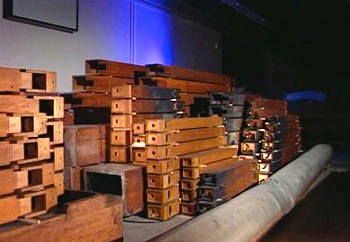
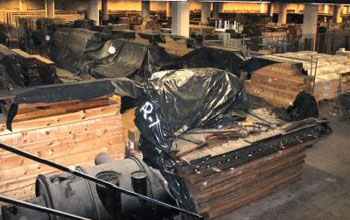
The Exposition organ is a vast machine. It has about 7500 pipes, weights 40 tons and has a footprint of over 800 sq. feet. The biggest wooden pipe weighs 1300lbs and is 32ft long, made from specially felled pine. The wooden air chest is 41ft. long, 15ft. wide and 7ft. high. The organ contains a tremendous amount of very good, old wood. It was manufactured by Austin Organs in Hartford, Connecticut and maintained by the local company Schoenstein & Co (who BAWA visited a couple of years ago)
After the Exposition it was moved into the Civic Auditorium and stayed there used for concerts and events until it was heavily damaged during the 1989 Loma-Prieta earthquake. In 1991 it was shipped back to the Austin Organ company for repair but after a few months the City stopped the repair work and the whole thing shipped back to San Francisco where it was put into storage in the Brooks Hall next to City Hall and there it has lain ever since in stacks of crates and bits covered with big plastic sheets. Problem is the City would like the organ moved out so they can use the hall for other things.
The Friends of the Exposition Organ face an enormous task trying to get the organ restored and back into working condition. Not only is the cost of repair a very expensive process the organization first needs to find a home for it. The days when an organ recital can pull audiences of many thousands of people are over and there are all already several old pipe organs in San Francisco that give concerts, including the Spreckels organ in the Legion of Honor.
I hope they succeed but if they give up and the bits go into a fire sale I will be there trying to buy a pipe or two.
For more information on the organ visit: expositionorgan.org
Enjoy your woodworking.
Frank (Contact at: Frankramsay8@aol.com)
Frank Ramsay called the meeting to order at 7:00 pm and asked that guests introduce themselves.
Two guests, Mike and Jim briefly described their respective interests in woodworking.
Announcements:
Per Madsen, the Program Director, summarized the upcoming schedule of meetings and seminars.
Sat. April 18: Rebuilding Together in San Bruno
Sat. May 2: Technical Seminar on Leigh Jig Cut Dovetails at John Blackmore's shop. Those members interested in attending should email John at johnblackmore@comcast.net. The hours are 9 am to 1 pm. His address is 620 Eastview Way, Redwood City. 94062
Thurs. May 21 Regular BAWA Meeting—Far West Forest Products: Jennifer Alger on the WoodMizer.
Thurs. June 18 Regular BAWA Meeting—Alan Olson, Educational Tall Ships. They are restoring a Tall Ship and this meeting will be a prelude to a Saturday visit to the ship.
Thurs. July 16 Regular BAWA Meeting—Ron Ashby, Shellac and Its Application
Thurs. Aug 20 Regular BAWA Meeting—Mark Christiansen of Wooden Windows in Oakland. This meeting will be held at the Wooden Window shop in Oakland.
Thurs. Sept 17—Regular BAWA Meeting—Dean Santner, Navigator Systems. He will describe the studio activity in Alameda.
John Blackmore, the new Treasurer, for BAWA announced that we have 57 members have renewed. Keep those checks coming in. Almost there.

Dan Goodman described the upcoming Rebuilding Together project to be conducted Saturday April 18 in San Bruno. The crew will be rebuilding a deck and fence. BAWA's Frank Taylor has already done the design work and some of the preliminary construction. Frank Taylor is to be commended for all of his preparatory work. It has been considerable. A tri-tip lunch will be served.
Several members brought in surplus items that are available for free and include:
Gallon of water based lacquer
Harbor Freight dust collector
55 gallon paper Oneida drum for dust collection
Grinding wheels
Dust collector top for trash can
½ Gallon of Deft lacquer
Stan Booker described some of the items available as door prizes this evening. The 8/4 maple plank will go to a lucky raffle prize winner tonight. Oops, our BAWA president won it.
John Lavine—Woodworker, Editor, Teacher, BAWA Wood Show Judge

John Lavine lives in Berkeley, CA and shares a shop with 7 other professional woodworkers in Alameda, CA. Starting two years ago, John began a new career as the head of the wood shop program within the Industrial Arts Department at Westmoor High School in the Jefferson High School District in Daly City, CA
John grew up in New York and graduated from Yale University as an English major and always wanted to be a writer. But, as many writers discover, he needed a day job to support his passion, so he became a carpenter. Living in the Bay Area, he formed a crew with two friends and took on high end remodeling jobs. In the 1980's he studied woodworking at Laney College in Oakland and became a shop-based artisan. Then, later in the 80's, a friend suggested he attend a lecture by a visiting Japanese Master Temple Builder in San Rafael. The Builder described with few English words and lots of demonstrated skill how he had rebuilt a family shrine in Japan. A curvilinear structure with no mechanical joints, no straight lines, and all joinery created with hand tools. In a brief 15 minute demonstration, the Builder was able to take a rough board and using hand tools only, smooth it, cut it evenly in half, then make a gooseneck, half-lapped, dovetail joint, joining the two boards with a barely discernable joint line. John was hooked. He joined the Builder's class and began a career as a custom furniture maker, later becoming editor of Woodwork magazine, then he became a teacher at Laney College. He is a member of the Bolinas Craft Guild.
Now he is two years into yet another career: high school teacher and wood/technology program director at Westmoor High School. Westmoor offers a Career Technical Education (CTE) program to its students. The program is focused on the industrial arts—sometimes called STEM (science, technology, engineering and math). CTE programs are supported by legislation introduced in 1949 by Carl E. Perkins, a Congressional Representative from Kentucky. This federal grant money, soon to come up for renewal, is given to states for allocation to school districts for the purchase of equipment, but not supplies. Please write your Congressman to support this legislation. How about extending it to include supplies, too?
At Westmoor, John teaches three woodshop classes and a technology program that includes drafting, manufacturing processes, machines, energy and electronics. He has added significantly to the equipment at Westmoor and the school has two SawStop tablesaws, a 22 inch band saw, a 24 inch planer, a 30 inch drum sander, several jointers, sanders and 5 lathes. He just installed a 48 inch-bed ShopBot CNC machine, introduced AutoCad, a 3D printer and is setting up a Fab Lab (fabrication laboratory). As John describes it: I am managing to stay just two days ahead of my students. Clearly he is evolving the program to meet the needs of his students in this century.
When students begin the program, the first and most important goal is to understand and adopt shop safety parameters. The safety test must be passed with a 100% grade before projects can begin. John holds up 10 fingers and says: 90% is not a passing grade.

Students early project: Mallets
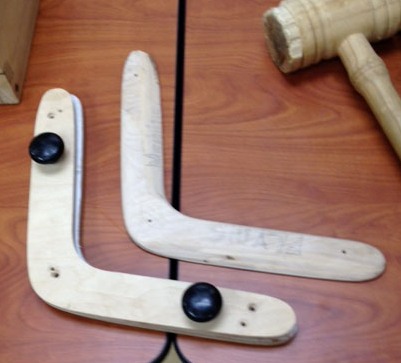
Early router project: Boomerang
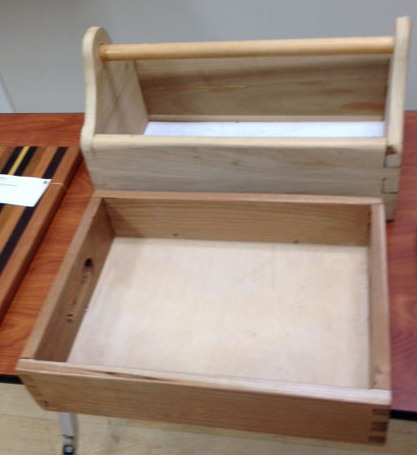
First handcut joints
The first project in the fall is to make a wooden spoon, then a wooden mallet. The results are quick and satisfying. Then in the late fall, students make breadboards and these products are sold at two sales in Berkeley during the year: Christmas and Mother's Day. The proceeds from the sales are split evenly between the student and the woodshop program. This arrangement gives the students income and the program monies to buy the supplies that are not provided under the CTE program funding. John receives additional supplies, including wood from suppliers and vendors that include Berkeley Mills, Home Depot, and PALs.
The program is changing to meeting the needs and technological requirements of our time. CAD, FAB LAB, SHOP-BOT and CNC are not just acronyms, but new technologies that will challenge the students today and into the tomorrows. John observes that many schools where wood shop had been abandoned, now regret having done so, but simply cannot afford to build a new program designed for today's students. The need, however, is here and now. Perhaps, we too can make a contribution.
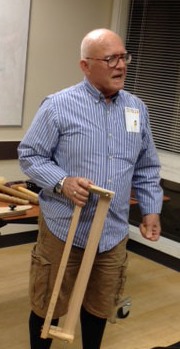
The irrepressible Arnie Champagne has found a new calling. After triple by-pass surgery, cervical surgery for compressed discs resulting from an automobile accident and surgeon threats of lumbar surgery to combat the after effects of hard-hat deep sea diving in the Navy, Arnie decided to use his woodworking skills to combat his back problems. Arnie has invented a spine roller that may put chiropractors out of business.
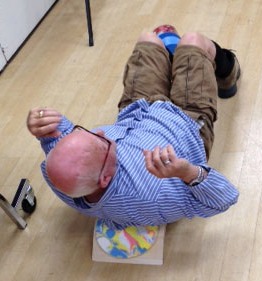
When we bend forward we stress our spinal musculature. Perhaps we need to bend backwards more often, a counter availing pressure. Arnie has devised a set of side-by-side twin foam cylinders mounted on a bar with handles on either end. When you place the roller under your back, with the space between the two cylinders under the spinal column, you can arch your back backwards, relieving muscle stress and tension. Lie on your back, with the rollers under your spine, then just roll it forward and back. Arnie and his friends have heard the snap of spinal release. Arnie used the "Rack and Roll" on the floor during the meeting. Arnie has provided prototypes to the Veterans Administration, his chiropractor and this newspaper editor. All this editor can say is "Amazing". Patents applied for.
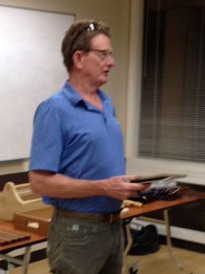
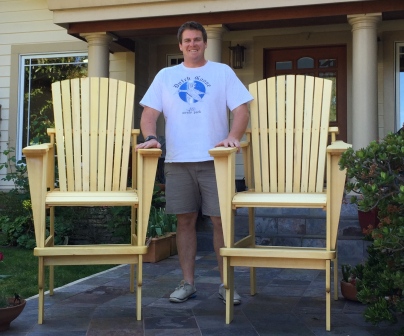
In keeping with the theme of John Lavine's presentation, John Blackmore told how in January this year a close friend of his eldest son had called with a request. They were water polo buddies in high school. Now, after college and a BA, Matt is studying to be a fireman. He is engaged, and his fiancée's parents live on the beach in Venice, CA. They like to sit on their deck and watch the beach promenade, putting their feet up on the deck railing. How better to watch the antics than from a high sitting Lifeguard style Adirondack chair. Only, who ever made one? Well, Matt designed it and we built two of them. Just check out this photo. Matt is by nature, a woodworker.
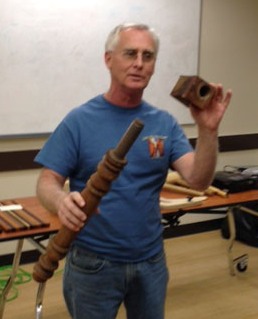
Ken Napior, a restorer of fine furniture, got a present. A friend has an old table that needs some refurbishment. The leg it seems is old and creaky. Wait, the table was made in 1902. How did they do things then? Let's remove the leg from the apron. It unscrews? Really? Yes, the leg has wood treads, and the apron piece is tapped. Where do I get this tooling?
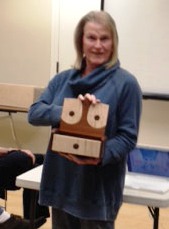
Kim Newberry likes to make boxes; fine hardwoods, veneers, intricate shapes, round surfaces. As a golfer, she knows swing and rhythm. Tonight she presented " The Crested Boob Box". What? Curved, laminate top of curly maple and walnut, closing over a rectangular box about 2 inches deep with a round 3/4-inch circle of walnut dead center on a maple background on the front. What happens when you open it?
Blazing Boobies: Open the top and two alluring walnut nipples inset into the curly maple, curved, veneered underside box top. Then there is that belly button on the front of the box: A woodworking fantasy. Bringing imagination to woodworking. Way-to-go-Kim.
And having aroused the Crowd, Frank decided to adjourn the meeting.
Thanks, everyone.John BlackmoreTreasurer
johnblackmore@comcast.net
